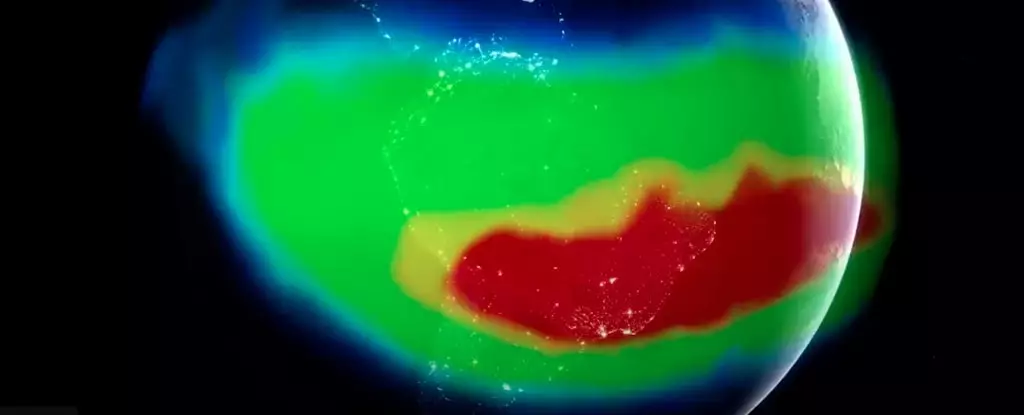The South Atlantic Anomaly (SAA) presents both a compelling scientific puzzle and a significant concern for various spacefaring technologies. This region, located between South America and southwest Africa, showcases a marked decrease in Earth’s magnetic intensity, drawing the attention of researchers, particularly within NASA. For years, this phenomenon has prompted extensive study regarding its origins, behavior, and implications for technology and science alike.
The SAA is often described as a “dent” in Earth’s magnetic field—a peculiar anomaly that resembles a pothole in space. While it does not pose immediate dangers to life on Earth, the SAA represents a challenging environment for orbital spacecraft. Satellites that traverse this region are increasingly susceptible to malfunction and data loss due to the exposure to charged solar particles. This heightened risk necessitates precautionary measures, including shutting down sensitive onboard systems prior to entering the anomaly zone.
NASA’s satellites and the International Space Station frequently navigate through this weakly magnetic area, where the diminished field strength can occasionally allow high-energy protons to penetrate spacecraft systems. While most encounters result in minor glitches, the potential for significant damage looms large, making the SAA a forefront concern for engineers and mission planners.
Origins in Earth’s Core
Geophysicists believe the SAA is the result of complex interactions within Earth’s outer core, specifically a swirling mass of molten iron situated miles beneath the Earth’s surface. The movements of this molten iron generate electric currents, which in turn produce Earth’s magnetic field. However, this field does not manifest uniformly. A dense region of rock beneath Africa, known as the African Large Low Shear Velocity Province, is thought to disrupt and weaken the magnetic field’s generation, leading to the dramatic intensity dip observed in the SAA.
Researchers indicate that the anomaly’s structure is indicative of a reversal in magnetic polarity, as evidenced by the growing localized field within the SAA that results in a significant drop in magnetic strength. This finding highlights the profound complexities of geophysical processes that govern Earth’s magnetic phenomena, shedding light on why the SAA has emerged as an object of scrutiny.
The SAA: Dynamics and Changes
When examining the SAA, it becomes clear that its dynamics are not static. In fact, NASA’s research has unveiled that the anomaly is not only drifting but also appears to be splitting in two. This unique behavior raises essential questions regarding its future trajectory. Recent studies have confirmed this bifurcation, revealing two distinct centers of low magnetic intensity encased within the anomaly itself.
Such observations suggest a need for continuous monitoring and analysis to determine the implications these changes may have on both Earth’s environment and orbital technologies. In a realm where many processes unfold over vast timescales, the observed alterations in the SAA signal a critical phase in a much longer cycle of geophysical activity.
One intriguing possibility is that the SAA is not merely a modern curiosity but rather a recurrent event that has manifested periodically over the last 11 million years. This revelation implies that the anomaly may not be a precursor to a sweeping magnetic field inversion, an event that occurs every several hundred thousand years and has profound implications for life on Earth. Instead, the SAA could represent a common developmental stage in Earth’s magnetic history.
Given the potential for the SAA to influence systems on a global scale, understanding its behavior and origins can provide essential clues about how Earth’s magnetic field operates over geological time. Researchers endeavor to determine the implications of this large-scale phenomenon, especially as new technologies continue to evolve and interact with it.
NASA’s commitment to monitoring the South Atlantic Anomaly reflects a broader understanding of its potential impacts across multiple domains, from space exploration and satellite technology to our fundamental understanding of Earth’s magnetic field. Nonetheless, despite years of research, many aspects of the SAA remain shrouded in mystery.
As our scientific tools and methods advance, the capacity to explore the SAA becomes increasingly feasible, prompting further investigations into its complex behavior. “The SAA may be slow-moving, but significant changes in its morphology are occurring,” notes geophysicist Terry Sabaka, underscoring the importance of sustained observation and research. The ongoing study of the SAA reveals not just an anomaly but an opportunity to deepen our understanding of dynamic processes at play beneath our feet and in the vastness of space. In an age where technology and nature intersect in profound ways, vigilance regarding anomalies like the SAA is critical for protecting technological infrastructure and advancing geological science.

